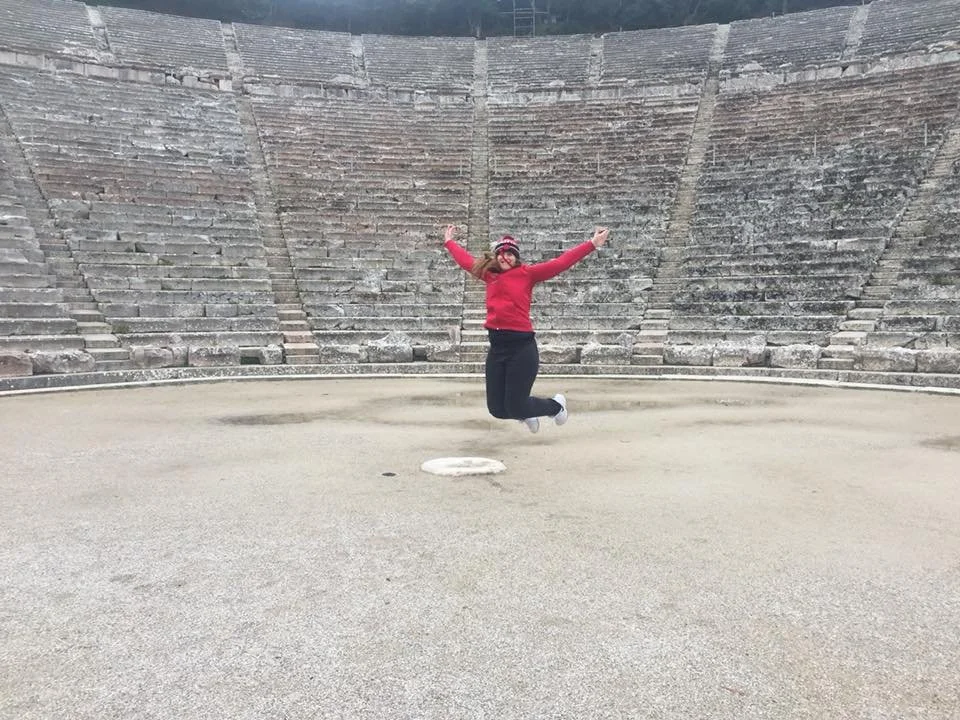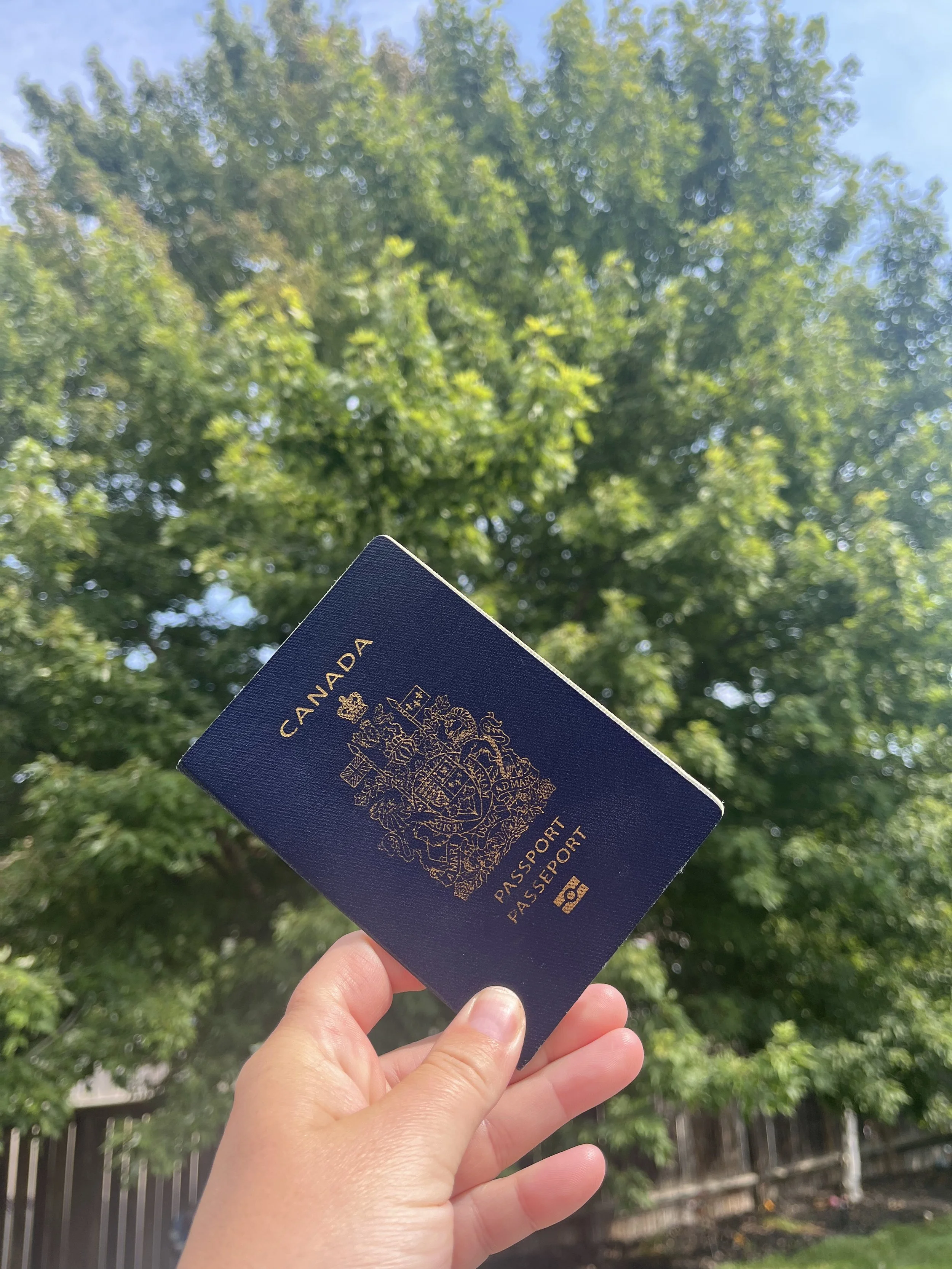The Solo Explorer’s Guide to Greece
✨ Intro
Greece is one of those countries that makes you feel like you’ve stepped into a history book — except the sunshine is real, the food is better, and the ruins are everywhere. I visited Greece in February, which meant cooler weather, fewer crowds, and some incredible moments I didn’t have to share with a million tourists.
From climbing the steps of the Acropolis to hiking through ancient monasteries at Meteora and eating roasted lamb in a quiet village — Greece surprised me in the best way. I traveled mostly by bus, ferry, and foot, crossing the country from Athens to the islands, then up through the mountains to the north.
This guide blends my real experience with practical tips for solo female travelers. Whether you're spending a week on the islands or circling ruins inland, here’s everything I wish I knew before I went.
Channeling my inner Greek drama queen — at the theatre of Epidaurus.
💁♀️ Why Greece Is Great for Solo Female Travelers
Easy to navigate with buses, ferries, and trains
Safe and welcoming, especially outside big cities
Packed with cultural and natural wonders
English is widely spoken in tourist areas
People are friendly and helpful — especially if you try a little Greek
Among columns and sunshine — Greece felt safe, welcoming, and full of wonder.
🧳 Entry Requirements (for Canadians & most tourists)
Tourists from Canada, the U.S., U.K., and most EU countries can visit Greece visa-free for up to 90 days within a 180-day period.
Your passport must be valid for at least 3 months beyond your planned departure.
No special vaccines or tourist visa needed for short-term travel.
ETIAS (a European pre-screening system) is expected to be required by mid-2026.
⚠️ Disclaimer: Entry requirements may change based on your nationality and government policies. Always check official sources before travel.
Passport in hand, ready to explore ancient history.
🕰️ Best Time to Visit
🌸 Spring (April–June) and 🍂 Fall (September–October) are ideal — warm weather, fewer crowds, and lower prices compared to peak summer.
☀️ Summer (July–August) brings the heat, festivals, and LOTS of tourists — especially on the islands.
❄️ Winter (November–March) is off-season, perfect for visiting ruins and cities like Athens without the crowds (but island ferries may run less often).
JD’s Tip:
I went in February — no lines at famous ruins, cheaper rooms, and a peaceful vibe. Some islands were quiet, but the mainland was full of life.
Also, many tourist attractions close early (some by 3:00 PM), so always check hours in advance — especially in the off-season.
Off-season Greece: trading beach days for hot drinks with a view.
💵 Money & Currency: How to Pay in Greece
💶 Local Currency: Euro (€)
💱 Exchange Rate: — 1 EUR ≈ 1.09 USD (as of August 2025)
💳 Cards: Credit cards (especially Visa & Mastercard) are widely accepted. Contactless payment (tap) is common.
💵 Cash: Useful for small cafés, markets, and local buses.
🏧 ATMs: Widely available — but avoid airport kiosks with poor exchange rates.
💡 JD’s Tip: Keep a little cash on hand for small purchases — some local spots still don’t take cards.
Disclaimer: Exchange rates are approximate and can change. Check current rates before you travel.
Euros — the colorful bills you’ll use all across Greece.
🛏️ Where to Stay
Booking Tips:
🏛️ In Athens, I wanted to stay near the Parthenon so I could walk through Plaka and catch nighttime views of the Acropolis — magical!
📍 Look for accommodation in Plaka or Monastiraki for easy access to ruins, museums, and metro lines.
Other Spots I Stayed:
🏖️ Santorini: I stayed in Akrotiri — quieter than Fira or Oia, with beautiful caldera views and budget-friendly prices.
🏘️ Delphi, Nafplio, and Meteora: I used Booking.com to find guesthouses and family-run inns.
⛰️ Litochoro (Mount Olympus): Great spot for hiking and mountain views.
JD’s Tips:
Travel in the off-season (February) = cheaper rates and fewer tourists.
Some guesthouses require cash payment — always check ahead.
Don’t expect elevators in small-town hotels — pack light!
A peek inside my Athens guesthouse — proof that comfort doesn’t need luxury.
🍽️ What to Eat
🥙 Gyros & Souvlaki – The ultimate street food. Gyros are pita wraps stuffed with meat, tomatoes, onions, fries, and tzatziki, while souvlaki are skewered meats — cheap, filling, and sold everywhere.
🥗 Greek Salad (Horiatiki) – Fresh tomatoes, cucumbers, olives, onions, and a slab of real feta cheese, drizzled with olive oil. Simple, refreshing, and perfect on a hot day.
🥧 Spanakopita – Flaky filo pastry stuffed with spinach, feta, and herbs. Found in bakeries across Greece — ideal for breakfast or a snack.
🍆 Moussaka & Pastitsio – Rich baked casseroles. Moussaka layers eggplant, potatoes, ground meat, and béchamel sauce, while pastitsio is like a Greek lasagna with pasta and cinnamon-spiced meat.
🍯 Baklava – Sweet layers of filo pastry filled with nuts and soaked in honey syrup. Sticky, crunchy, and unforgettable.
🍷 House Wine & Tavernas – Family-run tavernas often serve their own homemade wine — cheap, strong, and surprisingly good. Tavernas are usually more affordable (and tastier!) than big restaurants.
💡 JD’s Tip: Skip the tourist menus. Order what the locals are having, and don’t be afraid to ask for the daily special — it’s usually the freshest option.
Classic Greek street food — gyros, fries, and a cold beer.
🗺️Itinerary
Best Stops for a 2–3 Week Trip (With Time Suggestions)
🏛️ Athens – 2–3 days
History, food, Plaka, and the Acropolis
🕰️ Give yourself at least 2 full days to explore ruins and museums — and time to just wander the old streets at night.
🌅 Santorini – 2–3 days
Caldera sunsets, whitewashed villages, volcanic hikes
🕰️ Perfect for photos, chill time, and a volcano day tour. Off-season = fewer crowds.
🌊 Nafplio – 1 day (or overnight)
Coastal town with Venetian charm and fortress views
🕰️ Great base if visiting Epidaurus or Mycenae. Climb the fortress for epic views!
🏺 Mycenae & Epidaurus – Half-day each (1 day total)
Ancient ruins and theaters
🕰️ Best done as day trips from Nafplio or on a guided tour.
🔮 Delphi – 1 day
Mountainside oracle ruins + museum
🕰️ You don’t need long here, but it’s a must for ancient Greek vibes and views.
⛪ Meteora – 1–2 days
Cliff-top monasteries and hiking trails
🕰️ Spend the night in Kalambaka and explore the monasteries early before the buses arrive.
🏃 Olympia – Half-day to 1 full day
Birthplace of the Olympic Games
🕰️ Walk the original track — even in the rain, it’s magical. Combine with nearby towns.
🗻 Litochoro / Mount Olympus – 1 day (or more if hiking)
Mythical mountain base town
🕰️ Great for a peaceful reset or to explore the trails if you're adventurous.
🌆 Thessaloniki – 1–2 days
Greece’s underrated second city
🕰️ Laid-back, youthful vibe with waterfront views, cafes, and history — worth the detour north.
Channeling my inner oracle at Delphi — the seat fits, right?
🧭 Getting Around Greece
🚇 Metro
Use For: Athens only
💡 Tip: Line 3 connects the airport to the city
🚌 Buses (KTEL)
Use For: Intercity travel (cheap + reliable)
💡 Tip: Check timetables in advance. Buses can sell out fast — book tickets in advance, especially for popular routes
⛴ Ferries
Use For: Island travel (slow but scenic)
💡 Tip: Book early for major holidays. Be prepared for delays — we had to wait 12 hours once!
🚖 Taxis
Use For: Short city rides or late nights
💡 Tip: Ask for price or use metered taxis
🚶Walking
Use For: Exploring ruins & towns
💡 Tip: Good shoes are a must!
🚆Trains
Use For: Some long-distance routes
💡 Tip: Great for Meteora & Thessaloniki legs
🚗 Car Rental
Use For: Exploring Santorini, Nafplio, the Peloponnese, and smaller ancient sites that are hard to reach by public transport.
💡 Tip: We rented cars in Santorini and Nafplio to see nearby ruins and hidden spots. Driving in Athens can be stressful, but outside the city it’s a great way to explore. An International Driving Permit is officially required in Greece (depending on your home country), though when we visited, we rented cars without one. Rules may now be enforced more strictly, so check before you go.
Most of my long-distance trips were by bus — budget-friendly and a window seat guaranteed mountain views.
💸 Budget Breakdown / Day (in $USD)
Accommodation
Low: $28–45 — Hostels, budget hotels, guesthouses
Mid: $60–100 — Boutique hotels, B&Bs
High: $160+ — Luxury hotels, resorts
Food
Low: $12–20 — Street food, bakeries, casual cafés
Mid: $25–40 — Sit-down restaurants, mixed dining
High: $65+ — Fine dining, seafood feasts
Transport
Low: $8–15 — Buses, walking
Mid: $20–35 — Ferries, metro, occasional taxi
High: $60+ — Private transfers, rental car
Attractions
Low: $4–10 — Museums, small ruins
Mid: $15–30 — Combo tickets, major archaeological sites
High: $50+ — Guided tours, island day trips
👉 Total/Day
Low: $52–90
Mid: $120–205
High: $335+
💡 JD’s Tip: Visit major ruins early in the day before tour groups arrive — cooler temperatures and fewer crowds make for a better experience.
Renting a car gave us the freedom to explore Santorini at our own pace.
🛍️ Souvenirs to Buy in Greece
Olive Oil Products – Soaps, oils, and lotions made from local olives
Worry Beads (Komboloi) – A unique Greek gift that fits in your pocket
Evil Eye Charms – Known as mati, for protection and good luck
Handmade Ceramics – Inspired by ancient Greek patterns
Spices & Herbs – Oregano, thyme, and Greek mountain tea
Greek Sandals – Stylish and sturdy leather footwear
Local Wine or Ouzo – A taste of Greece in a bottle
Postcards from the Ruins – Great for scrapbooks or gifts
Jewelry from Local Shops – Affordable and meaningful pieces made by local artisans
When in doubt, follow the arrows — souvenirs this way!
🧘♀️ Solo Travel & Cultural Tips
Greet people with “Kalimera” (good morning) — it opens doors
Locals are helpful, especially at bus stations — just ask
Modest clothing is best for monasteries and churches
Expect stairs — lots of stairs (especially in Santorini and Meteora!)
Cafés are great places to rest and people-watch solo
In Greece, every path seems to come with steps — lots of them.
💡 JD’s Tips
Tourist sites close early in the off-season – In February, many attractions shut their doors by 3:00 PM. Plan accordingly!
Attractions were cheaper – Entry fees were noticeably lower compared to the high summer season.
Try local beer – February evenings were the perfect time to sip a Mythos or Alpha and unwind like a local.
Book buses in advance – I learned the hard way: intercity buses can sell out quickly, especially on weekends!
Pack for all weather – February brought everything from sunshine to chilly mountain air. Layers are your best friend.
A cold beer with a mountain view? That’s how Delphi does it.
🗣️ Speak a Little Greek
Nai — Yes — neh
Ohi — No — OH-hee
Kalimera — Good morning — kah-lee-MEH-rah
Efharisto — Thank you — eff-kha-ree-STOH
Parakalo — Please / You’re welcome — pah-rah-kah-LOH
Pou einai...? — Where is...? — poo EE-neh...?
Milate Anglika? — Do you speak English? — mee-LAH-teh ang-lee-KAH?
💡 JD’s Tip: Even if your pronunciation isn’t perfect, Greeks will appreciate the effort — it often leads to warmer service and friendly smiles.
No worries if your Greek is rusty — signs come with English too.













